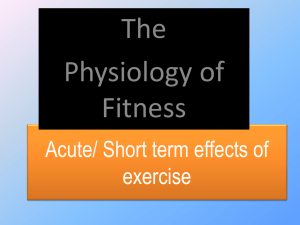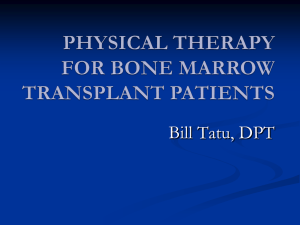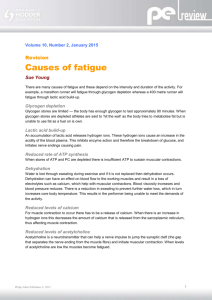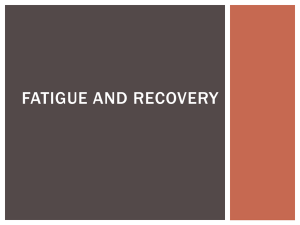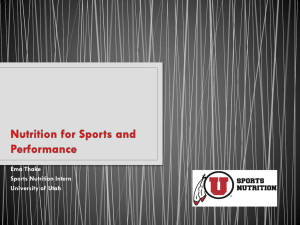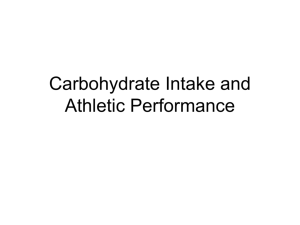Fatigue and Recovery in Sports: Strategies for Optimal Performance
advertisement
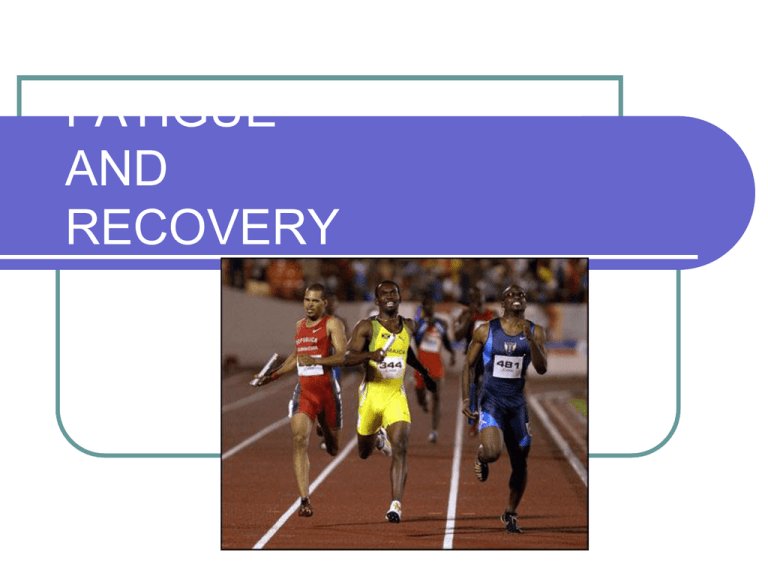
FATIGUE AND RECOVERY Key Skills and Knowledge At the completion of this topic, students should have knowledge of passive and active recovery methods to assist in returning the body to pre-exercise levels. At the completion of this topic, students should be able to: Explain the role the energy systems play in enabling activities to occur as well as their contribution to active and passive recovery. Explain the multi-factorial mechanisms associated with fatigue during physical activity and sporting events results from the use of the three energy systems under varying conditions. Compare and contrast suitable recovery strategies used to counteract fatigue and promote optimal performance levels. (VCE Study Design, 2010). Fatigue Chapter 6: Nelson textbook. Onset and rate of fatigue varies depending on: Type of activity Muscle fibres being used Types of muscle contractions Intensity and duration of activity (faster onset with high intensity) Fitness level. Fatigue Local fatigue- localised, related to a specific activity, eg. H++ accumulation, soreness from lunges (DOM’s). General fatigue- Physical and mental. Related to the whole training session; ie. Drained feeling. Long-term (chronic) fatigue- related to physiological and psychological stress caused by exhaustion and overtraining. Tired and will notice a deterioration in performance. Causes of Fatigue No single process is responsible. Due to changes in the internal conditions within the muscle such as: Depletion of fuels (ie. Glycogen and CP). Depletion of high energy P compounds. Increased body temperature Dehydration Changes in blood flow distribution. Altered level of metabolic by-products such as ADP. Fuel Depletion High Intensity Short Duration activities such as pole vault, rely on PC to fuel the ATP PC system. When PC stores deplete (10 seconds) the LA energy system takes over. This ES is less powerful. PC depletion ↓ Increase in inorganic phosphate ↓ Must decrease intensity when PC depleted >95% MHR PC Depletion Depletion of energy stores is a primary factor with fatigue. Once ATP-PC system is exhausted, body uses glycogen as an energy source (stored in muscles). Less oxygen available to working muscles. Restoration Rates Recovery Time (seconds) 30 Muscle Phosphagen restored 50% 60 75% 90 93% 120 95% 150 97% 180 98% 10 minutes 100% AEROBIC VS ANAEROBIC GLYCOLYSIS AEROBIC GLYCOLYSIS ↓ GLYCOGEN ↓ GLUCOSE ↓ PYRUVIC ACID SUFFICIENT OXYGEN ↓ CO2 + H20 + ATP ANAEROBIC GLYCOLYSIS ↓ GLYCOGEN ↓ GLUCOSE ↓ PYRUVIC ACID INSUFFICIENT OXYGEN ↓ L.ACID + H IONS +ATP Recovery Chapter 12 in Nelson, p. 285. During recovery the body overcompensates for the stress placed on it and adaptations result. The principle of recovery states: “in order to maximise performance and fitness benefits, an athlete must recover adequately from one training stimulus before the next stimulus is introduced” (Nelson, 2008). Recovery All athletes need different recovery strategies. Determined by: type of training undertaken; intensity and duration. Recovery Strategies As part of training session: passive and/or active recovery and stretching. Replenishment of fuels (carbohydrates) Replenishment of fluids + electrolytes. Hydrotherapy: cryotherapy, ice baths, pools sessions. Massage Hyperbaric Chamber- 100% pure O2, more to fatigued muscles to increase recovery rate. Psychological Techniques: eg. Progressive Muscle Relaxation (PMR), Meditation, breathing techniques, mental imagery. Cool Down Passive rest- replenishes CP stores most rapidly. Stretching- to prevent DOMS, PNF and static stretching as part of cool down whilst muscles are warm. Active recovery- removes lactate. Min. 5-1mins low intensity exercise (<70%hr max) to maintain high O2 levels required to breakdown lactate. Prevents venous pooling. Hydrotherapy Hot-Cold Showers- vasoconstriction (cold) and vasodilation (hot) causes a shunting effect in the blood vessels which speeds up removal of metabolites. Pool sessions: usually next day as recovery session due to reduced stress of weight bearing on joints. Cryotherapy- immersion in cold water such as ice bath. Reduces swelling caused by soft tissue damage. Eg. High collision sports and where repetitive action causes muscle micro trauma. Massage Stimulates increased blood flow which: Increases O2 delivery to muscles, increases removal of metabilites. Relaxes muscles and reduces muscle tightness improving joint movement. Breaks down scar tissue assisting with muscle repair. Relieves swelling. Progressive Muscle Relaxation Tensing and relaxing muscles enabling athlete to understand the difference between tensing and relaxing muscles. E.g. isolate one muscle group, create tension for 8-10 seconds then let the muscle relax and the tension go. Develops skills for releasing tension, resulting in decreased muscle tension. Meditation Relaxing by controlling the CNS and reducing the number of cues to the brain. Less stimulation results in lower blood pressure and HR, slower breathing and relaxed muscles. Other: Compression Clothing Claimed to accelerate recovery by: Increases venous return Reduces exercise induced muscle damage Accelerates recovery processes Removes lactic acid faster Increases muscle oxygenations Improves body temperature control. Replenishment of Fuels Immediately after exercise: Replenish CHO stores by consuming 5100g high GI foods within first 15 mins of finishing exercise. Eg. Jelly beans, crumpets with honey, jam sandwich. Consume CHO and protein together (4:1). Glycogen Replenishment Over next 2 hours athlete should consume 25-50g CHO every 15 mins (this maintains high insulin levels). After 2 hours CHO consumption should continue at a rate of 50g every 2 hours for 24 hours. It can take 24-48 hours to fully replenish CHO. Glycogen Levels Post event glycogen intake (High GI) Within 1 hour 1-2 hours 5+ hours Glycogen returns to pre-exercise levels 55% restored in next 5 hours 100% restored within 24 hours 100% restored 24-48 hours Up to 5 days Role of Protein Protein is broken down following intense exercise. The addition of protein to CHO amplifies the insulin response and promotes increased glucose delivery to the depleted cells. Insulin stimulates protein synthesis and helps reduce protein breakdown which assists in the growth and repair of muscle tissue. Hydration Assessing fluid requirements: 1. Weigh yourself before and after training and competition. 2. One kg of weight lost = 1 litre of fluid lost = 1-1.5 litres of fluid required. Aim to drink similar amount of fluid in future training and competition to prevent dehydration. Hydration during events: 250ml isotonic sports drink every 15 mins. Isotonic- similar to blood composition Hypertonic- > sugars Hypotonic- < sugars. Sports Drinks Contain CHO and electrolytes and flavouring making it easier to drink. Contain sodium which aids in retention of fluid without stopping thirst mechanism. Aid in replenishment of glycogen. Consume 500-1000ml per hour of isotonic drinks in end. Are emptied from stomach faster than water (if CHO content of 6-8%). Dehydration Occurs when fluid loss exceeds fluid intake. Effects include: Mental meltdown, Decreased reaction times, concentration and decision making. Elevated body temperature leads to increase blood redistributed to the skin in an effort to cool down. Decreased blood to muscles and decreased O2 available and increased reliance on LA system and H+ accumulate. Blood thickens- harder to pump, less blood delivered to the muscle and decreased amount of O2 available for aerobic glycolysis and to oxidise LA. Revision Questions 1. 2. 3. 4. 5. 6. 7. After an intense game of netball, would a passive or active recovery be required and why? What other non-dietary strategy could the netball player use as part of her recovery? A football player received some heavy knocks during the game. What type of recovery strategy may be useful? A Tour de France cyclist has completed a 180km stage ride. What is the first thing he should do to speed his recover? Name 3 recovery strategies that can decrease venous pooling and assist venous return. A dietary strategy is to ingest CHO protein in a 4: 1 ratio. How does this improve recovery? Is pasta or jelly beans better for recovery? ANSWERS References Malpeli, R. , Horton, M., Davey, G., & Telford, A. (2008). Nelson Physical Education VCE Units 3 & 4 (4th ed). South Melbourne; Cengage.




